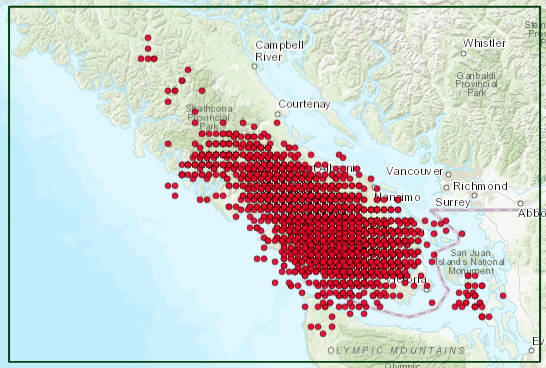Thousands of tremors rattled under Vancouver Island between Jan. 26 and Feb. 7, but experts say it isn’t out of the ordinary.
“I don’t think that this has any significance for hazards or changes in tectonics,” Steve Malone of the Pacific Northwest Seismic Network, who has a Ph.D. in geophysics, wrote in a Feb. 1 blog update. More than 6,200 tremors were recorded in just under two weeks.
Episodic tremors and slips (ETS) are non-earthquake seismological phenomenons that occur in subduction zones — such as the Cascadia subduction zone that runs from mid-coastal British Columbia to northern California. The Cascadia subduction zone occurs where the Juan de Fuca tectonic plate pushes under the North American plate, the length of which spans off the West Coast for more than 600 miles from northern Vancouver Island to Northern California. The subduction zone has produced megathrust quakes every 300 to 600 years, according to the Washington State Department of Natural Resources. The last magnitude 9 earthquake that struck the Cascadia subduction zone was in January 1700.
According to the PNSN, ETS events are occurring on average every 14 months, at least since the 1990s. This most recent incident was expected to begin around October 2020, according to the PNSN blog.
“The recent burst of activity in Southern Vancouver Island seems to be just that, a burst of a few days and not strong or long enough to be an ETS. The next ETS in this area could start as soon as early October or it might not be until January 2021,” Malone wrote in September. “Or there could be again two separate ETS events separated by months. ETS sequences are far from understood so any number of things are possible.”
Malone noted in the September blog post that the increase in activity in September 2020 was not unusual. By Oct. 9, Malone was posting the ETS event may have officially begun.
“Normally we like to wait to see a week of significant tremor every day before we think an ETS is really underway. There have been periods in the past where several days of tremor peters out just about the time we think a real ETS is going,” Malone wrote. “We definitely are in the time period, almost exactly 14 months since the beginning of the previous ETS.”
The previous ETS began on Aug. 11, 2019, according to Malone. He concluded that the ETS began on Oct. 4, 2020, and ended on Nov. 16, 2020. The ETS was observed as stretching from Portland, Oregon, northward to partway through Vancouver Island. For a month and a half after the ETS, Malone didn’t update the PNSN blog until on Feb. 1 he wrote “something has been going on.”
Beginning around Jan. 26 — the 321 anniversary of the last major Cascadia earthquake — tremors started under south-central Vancouver Island again and progressively got stronger and lasted longer, according to Malone. He added that the resurgence in tremors seems to just be part of the 14-month ETS cycle under which Cascadia has operated. While the activity is enough to be “out of the ordinary,” PNSN said in a Feb. 2 Twitter post, “‘ordinary’ still isn’t a very well understood term when it comes to tremor[s].”
“We have been monitoring this sort of activity for less than two decades; a short period over the 300-plus years since the last major earthquake,” Malone wrote. “We really don’t know what variations to expect over decade periods of time.”




